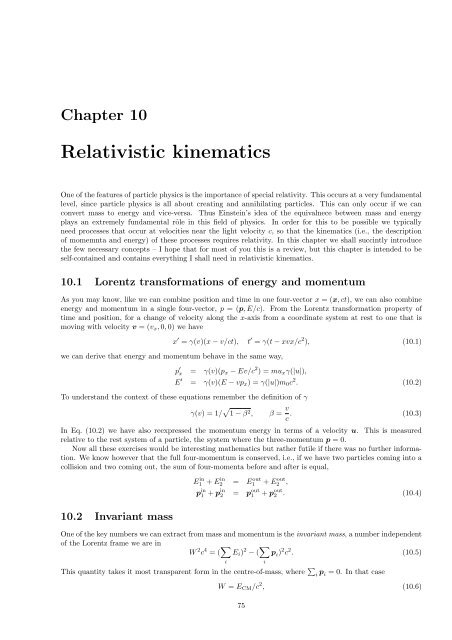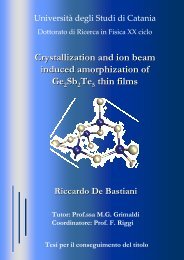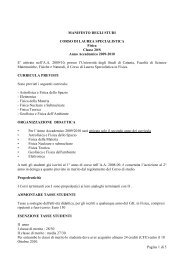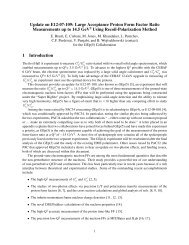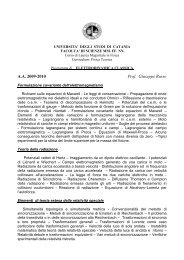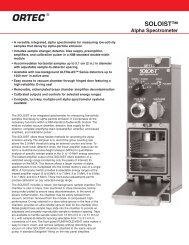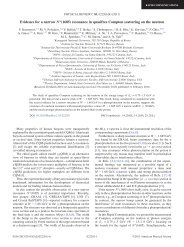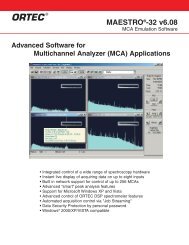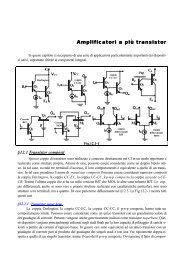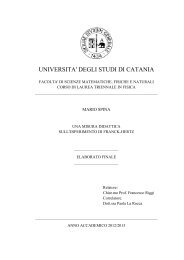Chapter 10 Relativistic kinematics
Chapter 10 Relativistic kinematics
Chapter 10 Relativistic kinematics
You also want an ePaper? Increase the reach of your titles
YUMPU automatically turns print PDFs into web optimized ePapers that Google loves.
<strong>Chapter</strong> <strong>10</strong><br />
<strong>Relativistic</strong> <strong>kinematics</strong><br />
One of the features of particle physics is the importance of special relativity. This occurs at a very fundamental<br />
level, since particle physics is all about creating and annihilating particles. This can only occur if we can<br />
convert mass to energy and vice-versa. Thus Einstein’s idea of the equivalnece between mass and energy<br />
plays an extremely fundamental rôle in this field of physics. In order for this to be possible we typically<br />
need processes that occur at velocities near the light velocity c, so that the <strong>kinematics</strong> (i.e., the description<br />
of momemnta and energy) of these processes requires relativity. In this chapter we shall succintly introduce<br />
the few necessary concepts – I hope that for most of you this is a review, but this chapter is intended to be<br />
self-contained and contains everything I shall need in relativistic <strong>kinematics</strong>.<br />
<strong>10</strong>.1 Lorentz transformations of energy and momentum<br />
As you may know, like we can combine position and time in one four-vector x =(x,ct), we can also combine<br />
energy and momentum in a single four-vector, p =(p,E/c). From the Lorentz transformation property of<br />
time and position, for a change of velocity along the x-axis from a coordinate system at rest to one that is<br />
moving with velocity v =(vx, 0, 0) we have<br />
we can derive that energy and momentum behave in the same way,<br />
x ′ = γ(v)(x − v/ct), t ′ = γ(t − xvx/c 2 ), (<strong>10</strong>.1)<br />
p ′ x = γ(v)(px − Ev/c 2 )=muxγ(|u|),<br />
E ′ = γ(v)(E − vpx) =γ(|u|)m0c 2 . (<strong>10</strong>.2)<br />
To understand the context of these equations remember the definition of γ<br />
γ(v) =1/ 1 − β2 , β = v<br />
.<br />
c<br />
(<strong>10</strong>.3)<br />
In Eq. (<strong>10</strong>.2) we have also reexpressed the momentum energy in terms of a velocity u.<br />
relative to the rest system of a particle, the system where the three-momentum p =0.<br />
This is measured<br />
Now all these exercises would be interesting mathematics but rather futile if there was no further information.<br />
We know however that the full four-momentum is conserved, i.e., if we have two particles coming into a<br />
collision and two coming out, the sum of four-momenta before and after is equal,<br />
<strong>10</strong>.2 Invariant mass<br />
E in<br />
1 + E in<br />
2 = E out<br />
1 + E out<br />
2 ,<br />
p in<br />
1 + p in<br />
2 = p out<br />
1 + p out<br />
2 . (<strong>10</strong>.4)<br />
One of the key numbers we can extract from mass and momentum is the invariant mass, a number independent<br />
of the Lorentz frame we are in<br />
W 2 c 4 =( <br />
Ei)<br />
i<br />
2 − ( <br />
pi) i<br />
2 c 2 . (<strong>10</strong>.5)<br />
This quantity takes it most transparent form in the centre-of-mass, where <br />
i pi = 0. In that case<br />
W = ECM/c 2 , (<strong>10</strong>.6)<br />
75
76 CHAPTER <strong>10</strong>. RELATIVISTIC KINEMATICS<br />
and is thus, apart from the factor 1/c 2 , nothing but the energy in the CM frame. For a single particle W = m0,<br />
the rest mass.<br />
Most considerations about processes in high energy physics are greatly simplified by concentrating on the<br />
invariant mass. This removes the Lorentz-frame dependence of writing four momenta. I<br />
As an exmaple we look at the collision of a proton and an antiproton at rest, where we produce two quanta<br />
of electromagnetic radiation (γ’s), see fig. <strong>10</strong>.1, where the anti proton has three-momentum (p, 0, 0), and the<br />
proton is at rest.<br />
p p<br />
Figure <strong>10</strong>.1: A sketch of a collision between a proton with velocity v and an antiproton at rest producing two<br />
gamma quanta.<br />
The four-momenta are<br />
From this we find the invariant mass<br />
<br />
W =<br />
pp = (plab, 0, 0,<br />
<br />
m2 pc4 + p2 labc2 )<br />
p¯p = (0, 0, 0,mpc 2 ). (<strong>10</strong>.7)<br />
2m 2 p +2mp<br />
If the initial momentum is much larger than mp, more accurately<br />
we find that<br />
W ≈<br />
<br />
γ<br />
γ<br />
m 2 p + p 2 lab /c2 (<strong>10</strong>.8)<br />
plab ≫ mpc, (<strong>10</strong>.9)<br />
<br />
2mpplab/c, (<strong>10</strong>.<strong>10</strong>)<br />
which energy needs to be shared between the two photons, in equal parts. We could also have chosen to work<br />
in the CM frame, where the calculations get a lot easier.<br />
<strong>10</strong>.3 Transformations between CM and lab frame<br />
Even though the use of the invariant mass simplifies calculations considerably, it clearly does not provide all<br />
necessary information. It does suggest however, that a natural frame to analyse reactions is the CM frame.<br />
Often we shall analyse a process in this frame, and use a Lorentz transformation to get informations about<br />
processes in the laboratory frame. Since almost all processes involve the scattering (deflection) of one particle<br />
by another (or a number of others), this is natural example for such a procedure, see the sketch in Fig. <strong>10</strong>.2.<br />
The same procedure can also be applied to the case of production of particles, such as the annihilation process<br />
discussed above.<br />
Before the collission the beam particle moves with four-momentum<br />
and the target particle mt is at rest,<br />
pb =(plab, 0, 0,<br />
<br />
m2 bc4 + p2 labc2 ) (<strong>10</strong>.11)<br />
pt =(0, 0, 0,mtc 2 ). (<strong>10</strong>.12)
<strong>10</strong>.4. ELASTIC-INELASTIC 77<br />
b<br />
t<br />
t<br />
b<br />
Figure <strong>10</strong>.2: A sketch of a collision between two particles<br />
We first need to determine the velocity v of the Lorentz transformation that bring is to the centre-of-mass<br />
frame. We use the Lorentz transformation rules for momenta to find that in a Lorentz frame moving with<br />
velocity v along the x-axis relative to the CM frame we have<br />
p ′ bx = γ(v)(plab − vElab/c 2 )<br />
p ′ tx = −mtvγ(v). (<strong>10</strong>.13)<br />
Sine in the CM frame these numbers must be equal in sizebut opposite in sign, we find a linear equation for<br />
v, with solution<br />
<br />
plab<br />
v =<br />
≈ c 1 −<br />
mt + Elab/c2 mt<br />
<br />
. (<strong>10</strong>.14)<br />
plab<br />
Now if we know the momentum of the beam particle in the CM frame after collision,<br />
(pf cos θCM,pf sin θCM, 0,E ′ f ), (<strong>10</strong>.15)<br />
where θCM is the CM scattering angle we can use the inverse Lorentz transformation, with velocity −v, to try<br />
and find the lab momentum and scattering angle,<br />
from which we conclude<br />
γ(v)(pf cos θCM + vE ′ f /c 2 ) = pflab cos θlab<br />
tan θlab = 1<br />
γ(v)<br />
pf sin θCM = pflab sin θlab, (<strong>10</strong>.16)<br />
pf sin θCM<br />
pf cos θCM + vE ′ . (<strong>10</strong>.17)<br />
f /c2<br />
Of course in experimental situations we shall often wish to transform from lab to CM frames, which can be<br />
done with equal ease.<br />
To understand some of the practical consequences we need to look at the ultra-relativistic limit, where<br />
plab ≫ m/c. In that case v ≈ c, and γ(v) ≈ (plab/2mtc2 ) 1/2 . This leads to<br />
tan θlab ≈<br />
<br />
2mtc2 u sin θC<br />
u cos θC + c<br />
plab<br />
(<strong>10</strong>.18)<br />
Here u is the velocity of the particle in the CM frame. This function is always strongly peaked in the forward<br />
direction unless u ≈ c and cos θC ≈−1.<br />
<strong>10</strong>.4 Elastic-inelastic<br />
We shall often be interested in cases where we transfer both energy and momentum from one particle to<br />
another, i.e., we have inelastic collissions where particles change their character – e.g., their rest-mass. If we<br />
have, as in Fig. <strong>10</strong>.3, two particles with energy-momentum k1 and pq coming in, and two with k2 and p2<br />
coming out, We know that since energy and momenta are conserved, that k1 + p1 = k2 + p2, which can be<br />
rearranged to give<br />
p2 = p1 + q, k2 = k1 − q. (<strong>10</strong>.19)<br />
and shows energy and momentum getting transferred. This picture will occur quite often!
78 CHAPTER <strong>10</strong>. RELATIVISTIC KINEMATICS<br />
<strong>10</strong>.5 Problems<br />
Figure <strong>10</strong>.3: A sketch of a collision between two particles<br />
2. Suppose a pion decays into a muon and a neutrino,<br />
π + = μ + + νμ. (<strong>10</strong>.20)<br />
Express the momentum of the muon and the neutrino in terms of the mass of pion and muon. Assume that<br />
the neutrino mass is zero, and that the pion is at rest. Calculate the momentum using m π + = 139.6 MeV/c 2 ,<br />
mμ = <strong>10</strong>5.7 MeV/c 2 .<br />
3. Calculate the lowest energy at which a Λ(1115) can be produced in a collision of (negative) pions<br />
with protons at rest, throught the reaction π − + p → K 0 +Λ.m π − = 139.6 MeV/c 2 , mp = 938.3 MeV/c 2 ,<br />
m K 0 = 497.7 MeV/c 2 . (Hint: the mass of the Λ is 1115 MeV/c 2 .)<br />
4. a) Find the maximum value for v such that the relativisitic energy can be expressed by<br />
E ≈ mc 2 + p2<br />
, (<strong>10</strong>.21)<br />
2m<br />
with an error of one procent.<br />
b) find the minimum value of v and γ so that the relativisitic energy can be expressed by<br />
again with an error of one percent.<br />
E ≈ pc, (<strong>10</strong>.22)


